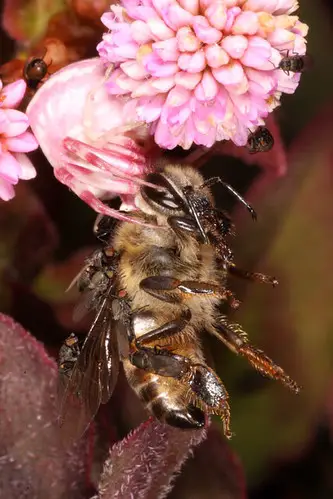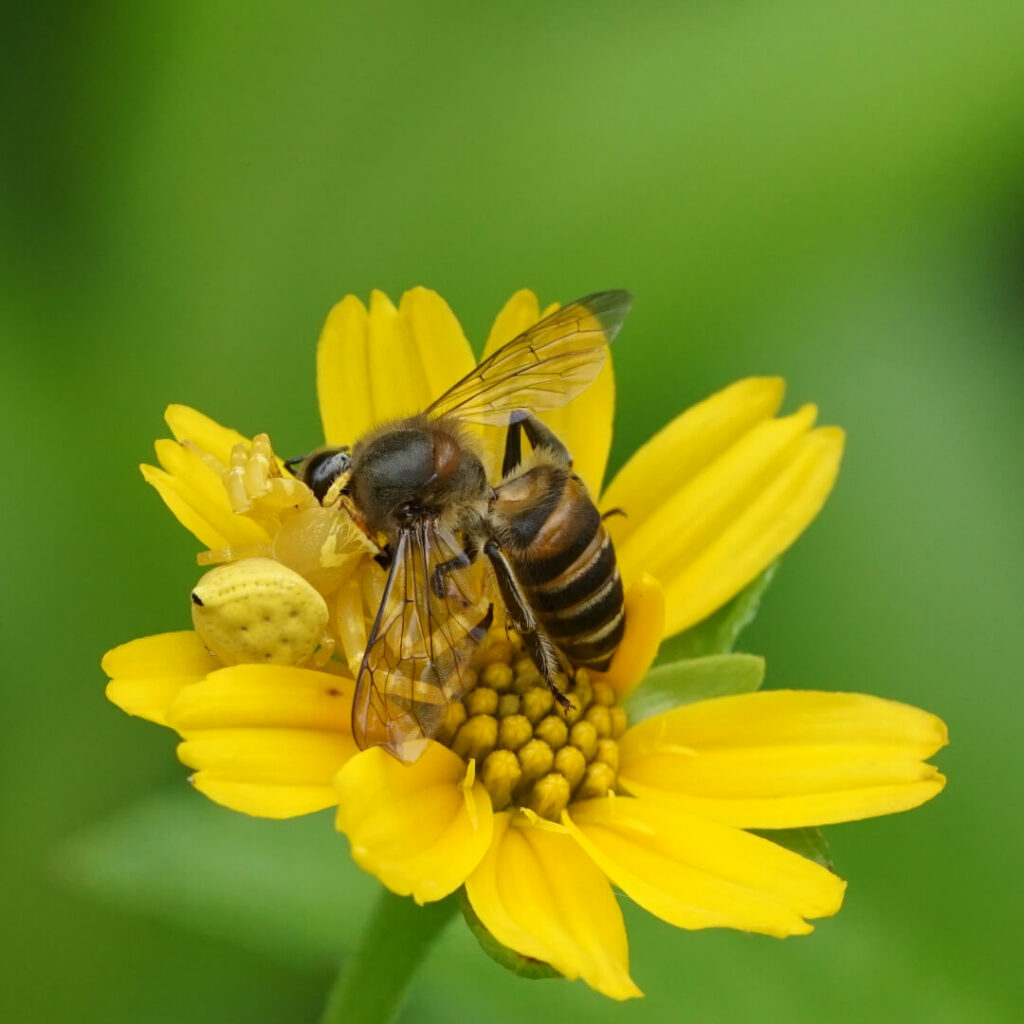Last updated on October 24th, 2023 at 03:19 pm
When you think of ambush predators, you might imagine a creature lurking in the shadows, waiting for the perfect moment to pounce. But some spiders flip the script. Instead of hiding, they make themselves—and the flowers they sit on—impossible to ignore.
Meet the crab spiders, the UV-reflecting stars of the ambush world. They’ve evolved this flashy hunting technique, making them a fascinating subject for researchers like Felipe Gawryszewski at the Federal University of Goiás in Brazil.
In the fascinating world of insects, ambush hunters like crab spiders typically rely on the element of surprise to catch their prey. These spiders, belonging to the Thomisidae family, opt to remain hidden and camouflaged until the perfect moment to strike.
*Additional reading – Don’t miss our deeper look into do spiders eat bees.

Researchers have discovered that this intriguing hunting strategy has evolved multiple times among different crab spider species.
By analysing genetic information and constructing a “family tree” of 68 crab spider species from Australia, Europe, and Malaysia, it was uncovered that flower-dwelling crab spiders exhibit a higher level of UV reflection compared to those that hunt on other substrates like bark and leaves.
This remarkable sensory exploitation technique has proven to be quite effective, as bees, including honeybees and Australian native bees from the Hymenoptera order, are more inclined to visit flowers when UV-reflecting spiders reside atop them.
Quick Facts:
- Researchers: Felipe Gawryszewski and team
- Species Studied: 68 species of crab spiders
- Regions: Australia, Europe, and Malaysia
- Hunting Style: Sit, wait, and pounce
The Science Behind the Flash
Interestingly, some species of crab spiders, such as Misumena vatia and Australian crab spider Thomisus spectabilis, have adopted a unique and dazzling strategy – reflecting ultraviolet light to make the flowers they inhabit more alluring to bees.
These crab spiders are like the ultimate actors of the animal kingdom. They don’t just reflect UV light; they use reflection to mimic their background colours. This isn’t just about being flashy; it’s about blending in to become the ultimate ambush predator.
Crab spiders have specialised cells that allow them to reflect light in a way that changes their pigment colour. It takes a couple of days but this enables them to mimic the colours of the surfaces they’re on, whether it’s a flower, a leaf, or tree bark. It’s like they have a built-in wardrobe that adapts to their surroundings.
Gawryszewski and his team collected data from 68 species of crab spiders across Australia, Europe, and Malaysia. These spiders employ a “sit, wait, and pounce” strategy, but not all of them do it in the same way. Some prefer dull backgrounds like bark and leaves, while others go for the floral stage.
After piecing together a genetic “family tree,” the team discovered that flower-based hunting has evolved multiple times. And guess what? The flower-loving spiders reflect more UV light than their tree-hugging cousins.
The UV Factor:
| UV-Reflecting Spiders | Non-UV Reflecting Spiders |
|---|---|
| Hunt on flowers | Hunt on bark and leaves |
| Attract more bees | Less attractive to bees |
The Bee’s Knees or a Spider’s Web?
So, why do bees fall for this UV trick? One theory suggests that bees mistake these spiders for “floral guides,” those natural bright spots on flowers that help pollinators find their way.
Another theory posits that bees have a colour preference that spiders exploit. But it’s not all sunshine and roses for these spiders. Reflecting UV light might attract more prey, but it could also make them a target for other predators.
It is fascinating how nature works in mysterious ways, and one such example is the interaction between bees, crab spiders, and flowers. Bees are essential pollinators which are attracted to flowers by ultraviolet (UV) light patterns, guiding them to the landing platform.
Crab spiders, on the other hand, are ambush hunters who do not create webs, but interestingly, they reflect UV light to lure bees towards them. This makes the flowers they sit on appear brighter and more attractive to bees.
Theories on Bee Attraction:
- Mistaking spiders for floral guides
- Preference for certain color patterns
The Final Buzz
In the realm of sensory and visual ecology, recent studies have started to provide evidence backing the theory that UV reflectance in crab spiders is connected to the evolution of a flower-based hunting strategy.
As more research delves into this subject, we can unravel the mysteries behind these intriguing interactions in nature and gain a deeper understanding of the complex relationships between pollinators, predators, and flowers.
This study is groundbreaking because it’s the first to back up the idea that UV reflectance in crab spiders is tied to their flower-based hunting strategy. So the next time you see a flashy flower, think twice. It might just be a spider’s dinner table.
Questions to Ponder:
- Could this UV-reflecting strategy be a double-edged sword for spiders?
- How might this research impact our understanding of bee behaviour?
- What other animals could be using similar strategies that we haven’t discovered yet?
- What animals eat bees?
Now, you might be wondering, what does this have to do with bees and our mission at Revive a Bee? Well, understanding the tactics predators use to lure bees can help us better protect them. After all, every bee counts when you’re trying to save the world, one buzz at a time.
David Attenborough’s Life in Colour
First aired on the 7th of March 2021, David Attenborough’s Life in Colour, episode 2 of 2, which was also shown on BBC1 last night (October 15th 2023) details how crab spiders attract bees by reflecting ultraviolet light. If you want to watch the full episode it’s still available for the next 4 months on BBC iPLayer.
Featured Image Credits: “Spider” by Vengolis is licensed under CC BY-SA 4.0.




